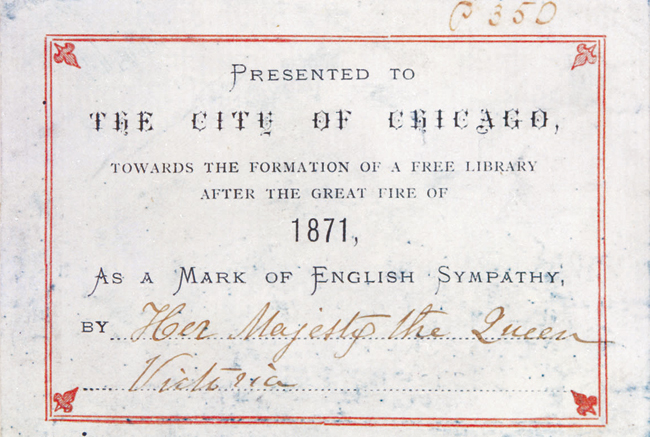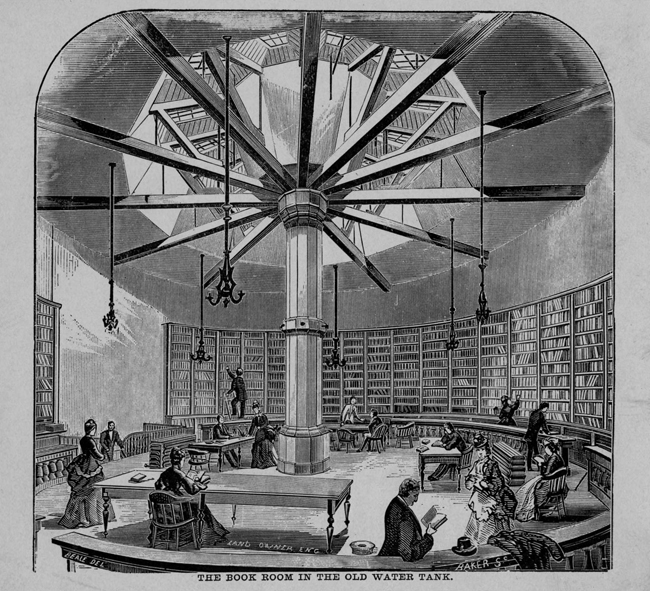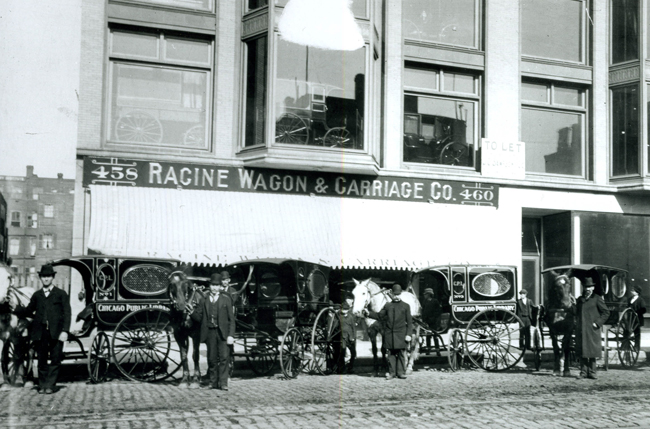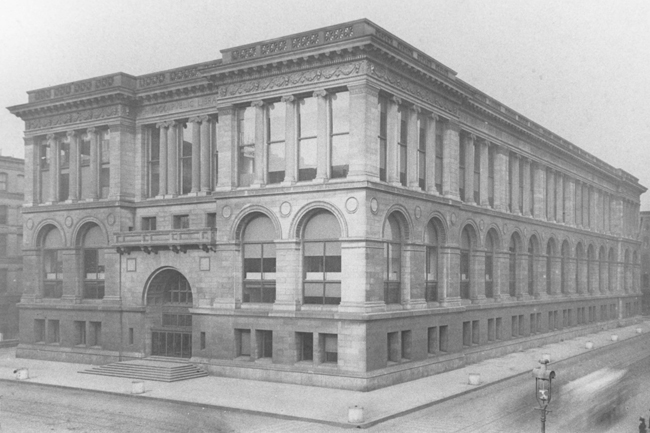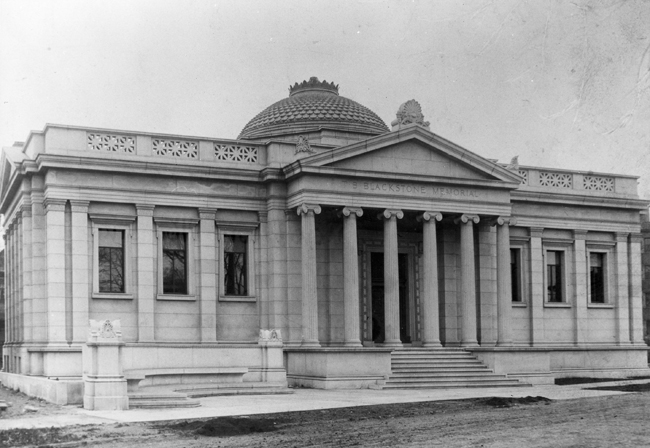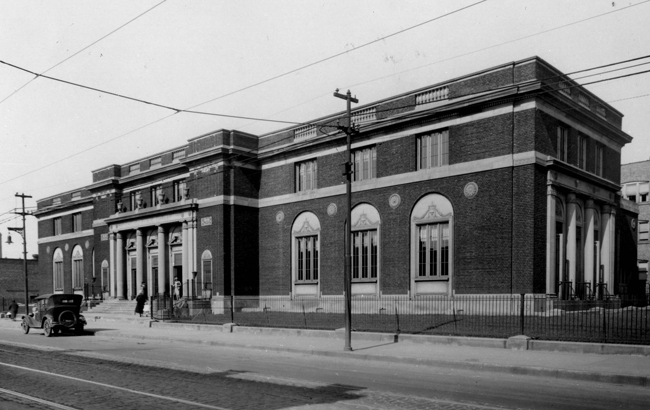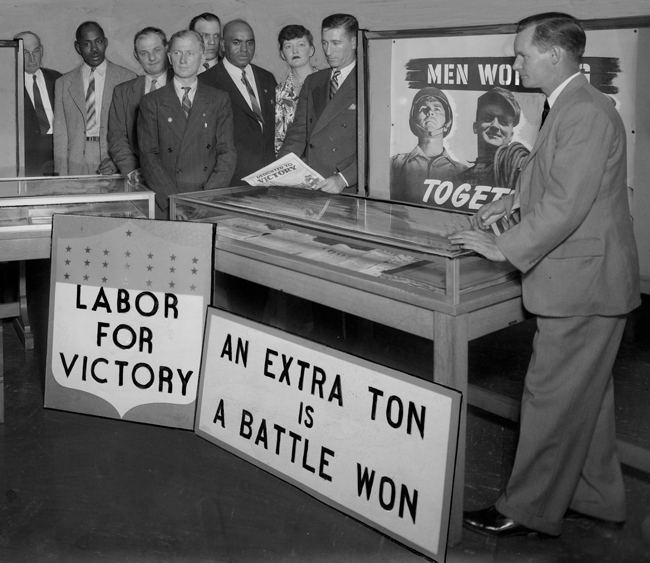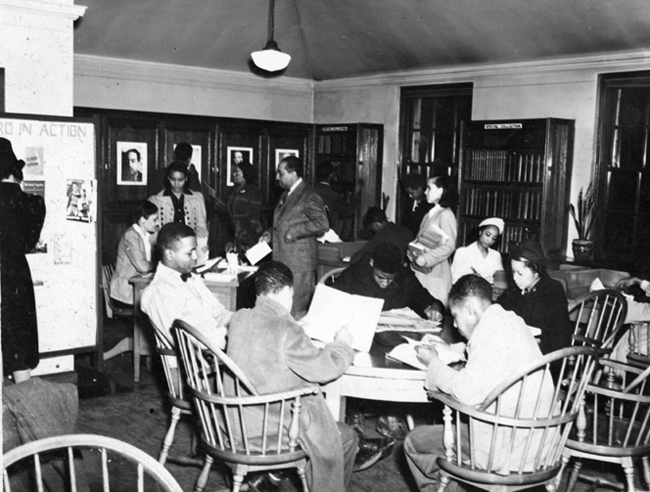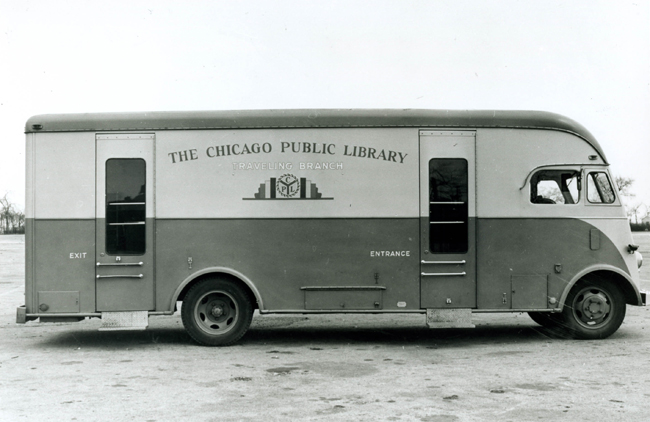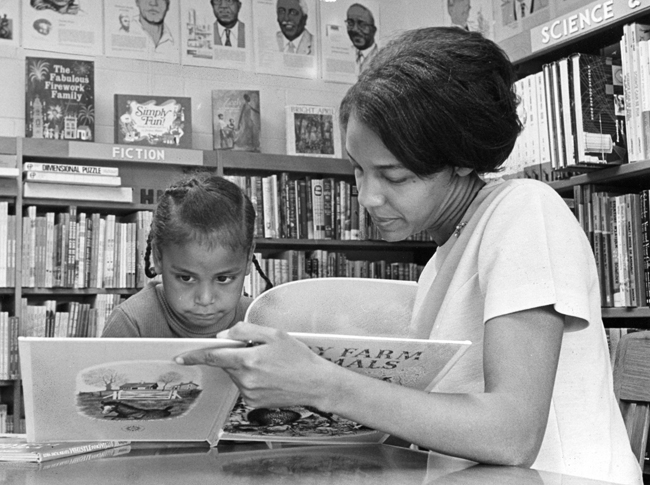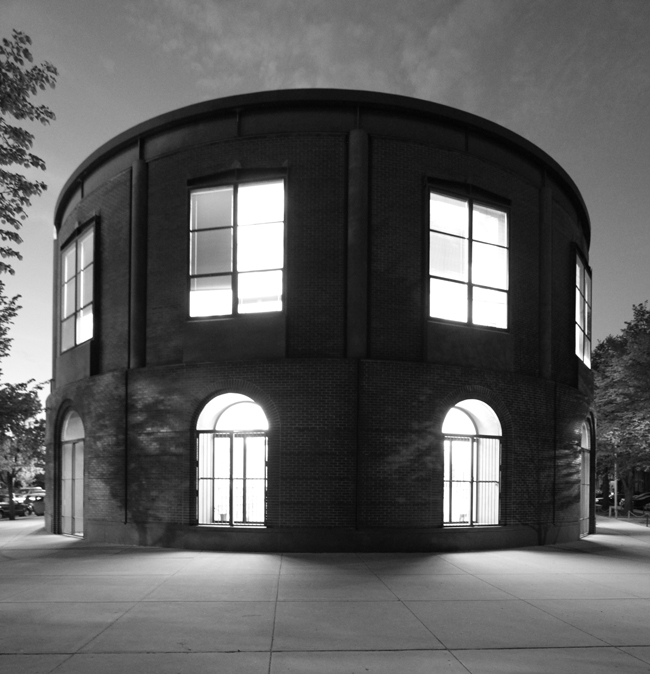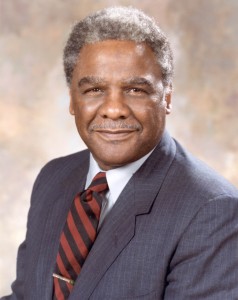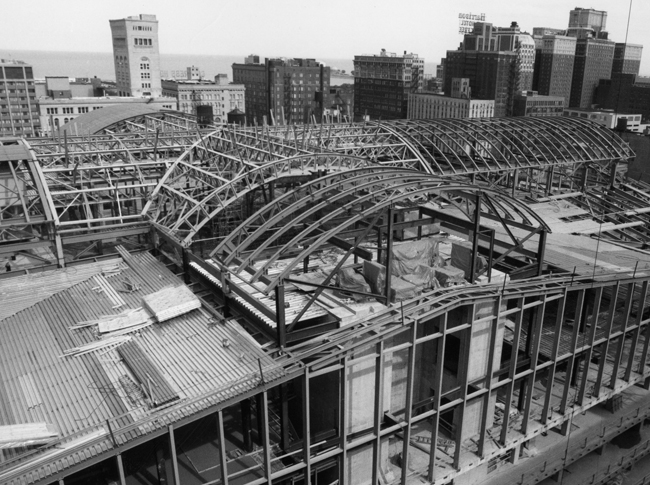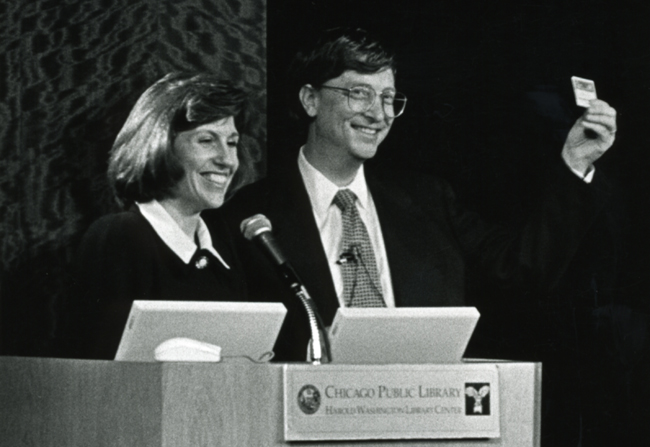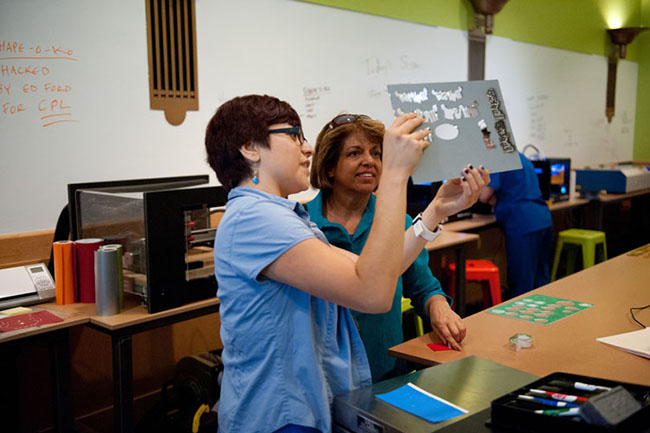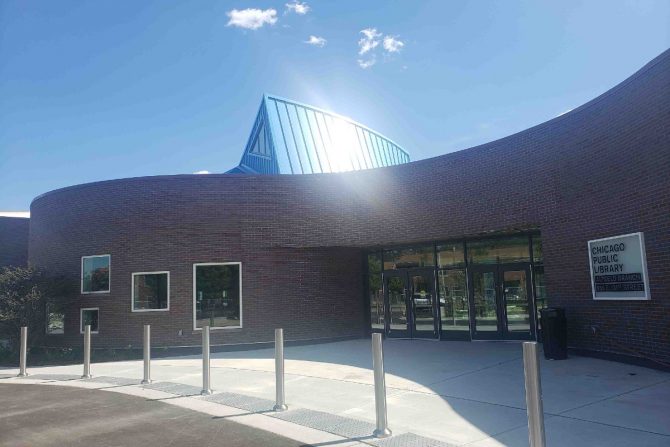1871
After the Great Chicago Fire, which began October 8, A.H. Burgess of London proposed an “English Book Donation,” which he described in the Chicago Tribune on December 7: “I propose that England should present a Free Library to Chicago, to remain there as a mark of sympathy now, and a keepsake and a token of true brotherly kindness forever…”
The plan carried the support of Thomas Hughes, a prominent member of Parliament and the well-known author of Tom Brown’s School Days, who had visited Chicago in 1870.
The donation, consisting of more than 8,000 books from Great Britain, prompted leading citizens of Chicago to petition for a public meeting to establish a free public library. Previous libraries in Chicago were private organizations that required membership fees. The public meeting led to the Illinois Library Act of 1872, which authorized cities to establish tax-supported libraries throughout the state.
1872
In April, the City Council passed an ordinance proclaiming the establishment of Chicago Public Library.
1873
On January 1, Chicago Public Library opened its doors at the southeast corner of LaSalle and Adams streets in a circular water tank that survived the fire.
On October 24, the Chicago Public Library board elected William Frederick Poole as librarian. The library moved several times during its first 24 years, including an 11-year stay on the fourth floor of City Hall.
1874
A delivery station system of outposts with small collections served Chicago's neighborhoods. Most stations were in stores and were managed by store personnel. Patrons could call for a specific book, which was delivered by horse-drawn carriage to the outpost nearest their home.
Over the next decade, deposit stations included local candy or drug stores, where owners were paid a modest sum for accepting books for delivery and retrieval. “Special” deposit stations included businesses, churches and factories, where books were available for employees or members.
By the early 1900s deposit stations accounted for two-thirds of the circulation of the Chicago Public Library.
1891
Jane Addams provided space for a reading room in the Butler Gallery of Hull House. The typical reading room could be found in Chicago’s many park fieldhouses or on the upper floors of businesses.
1897
On Monday, October 11, the Central Library, on Michigan Avenue between Washington and Randolph streets, opened its doors. The building, on the grounds of Dearborn Park (named for the Fort Dearborn Military Reservation that formally encompassed the area), cost about $2 million. The building was designed by A.H. Coolidge, associate of the firm Shepley, Rutan & Coolidge of Chicago, with 25 draftsmen taking a year to complete about 1,200 drawings. Heedful of the lessons of the Great Chicago Fire, they designed the building to be practically incombustible.
The center of this building, now known as Preston Bradley Hall, contains a dome and hanging lamps designed by Tiffany Glass and Decorating Company of New York. The Washington Street entrance, grand staircase and dome area contain inscriptions of 16th century printers’ marks, authors’ names and quotations that praise learning and literature in mosaics of colored stone, mother of pearl and favrile glass.
The bill to erect a public library on the grounds of Dearborn Park also required the inclusion of a Soldiers’ and Sailors’ Memorial Hall to commemorate the soldiers and sailors from Illinois who served in the Civil War.
1904
Isabella N. Blackstone presented Chicago Public Library with funding to construct its first branch library, in memory of her late husband, Timothy Beach Blackstone. Mr. Blackstone served as president of the Chicago and Alton Railroad from 1864 until 1899, and was one of Chicago’s leading philanthropists. The library was modeled after the famous Erechtheion on the Acropolis in Athens, Greece. Today, Blackstone Branch serves the Hyde Park and Kenwood neighborhoods, and remains a vital part of Chicago Public Library.
1916
Chief Librarian Henry E. Legler presented his library plan for the city, which called for an extensive network of neighborhood library locations. Its goal was to bring “library service within the walking distance of home for every person in Chicago who can read or wants to use books.”
Legler believed several regional libraries with more comprehensive collections than the neighborhood library locations would provide patrons with greater library resources within a reasonable distance. The first regional library, the Henry E. Legler Regional Library, was established in 1920 in the West Garfield Park neighborhood. Legler Regional Library remains part of the Chicago Public Library and is listed in the National Register of Historic Places.
1918
Carl B. Roden, who began work as a library page in 1886, was appointed chief librarian, a position he held for 32 years (1918-1950). Under his leadership, the library system increased 50 percent, staff more than doubled, the book stock increased threefold, circulation doubled and total expenditures rose more than 400 percent. Roden Branch in the Norwood Park neighborhood, where Roden lived his whole life, is named in his honor.
1932
The George Cleveland Hall Branch, in the Bronzeville neighborhood, opened under the leadership of branch head Vivian Gordon Harsh and children’s librarian Charlemae Hill Rollins.
Harsh, CPL’s first African American branch head, inspired and motivated authors, poets and writers at the library and established the largest African American history and literature collection in the Midwest.
Rollins, an energetic author, lecturer and storyteller, served as the first African American president of the Children’s Services Division of the American Library Association.
The branch was named in honor of Dr. George Cleveland Hall, chief of staff for Provident Hospital and the second African American on Chicago Public Library’s Board of Directors.
1951
Under the direction of Chief Librarian Gertrude E. Gscheidle, the Chicago Public Library expanded its service to Chicago’s neighborhoods by modernizing the bookmobile system. In fewer than eight months of operation, the traveling branch system circulated almost 100,000 books to neighborhoods without full library services.
1960s
Chicago Public Library added a significant number of neighborhood branch libraries, either through new construction or by leasing storefronts or reading rooms. By 1985, there were 76 such locations throughout Chicago.
1975
Carter G. Woodson Regional Library, named after the “Father of Modern Black Historiography,” opened its doors in December. Woodson Regional Library, in the Washington Heights neighborhood, is home to the Vivian G. Harsh Research Collection of Afro-American History and Literature. Named in honor of the first African American woman to head a location of the Chicago Public Library, the Harsh Collection is one of the largest repositories of information on the black experience in the Midwest.
1985
Conrad Sulzer Regional Library, in the Ravenswood neighborhood, replaced Hild Regional Library and serves the North Side of Chicago. Designed by the architectural firm of Hammond, Beeby & Babka, the building is an example of neoclassical architecture. Sulzer Regional Library houses the Northside Neighborhood History Collection.
During the years of great neighborhood library expansion, it became increasingly clear that the Chicago Public Library had outgrown its Central Library on Michigan Avenue. Mayor Harold Washington and Chicago’s civic leaders planned for the construction of a new central library, designating a site at 400 S. State Street, a one-and-one-half block tract in the South Loop.
1986
The Chicago Public Library Foundation was formed as an independent, nonprofit educational organization dedicated to working with the City of Chicago in a public/private partnership benefiting the Chicago Public Library. Support from the Chicago Public Library Foundation is instrumental in enhancing book collections, online information access and innovative programs for Chicagoans of all ages.
1987
On July 29, Mayor Harold Washington and the City Council authorized a design/build competition and approved a bond issue to finance the project. Under the rules of the competition, architects and builders teamed up to design the building within the set cost of $144 million. The winning entry from the SEBUS Group included developers U.S. Equities; design architects Hammond, Beeby & Babka Inc.; general contractors Schal Associates Inc.; architects of record and structural engineers A. Epstein and Sons, International; and architects and engineers Delon Hampton & Associates.
CPL's Board of Directors decided to name the new central library after the late Mayor Washington, the city’s first African American mayor. A great lover of books and an advocate of Chicago Public Library, Washington died November 25, 1987.
1988
The groundbreaking for Harold Washington Library Center took place October 13.
1991
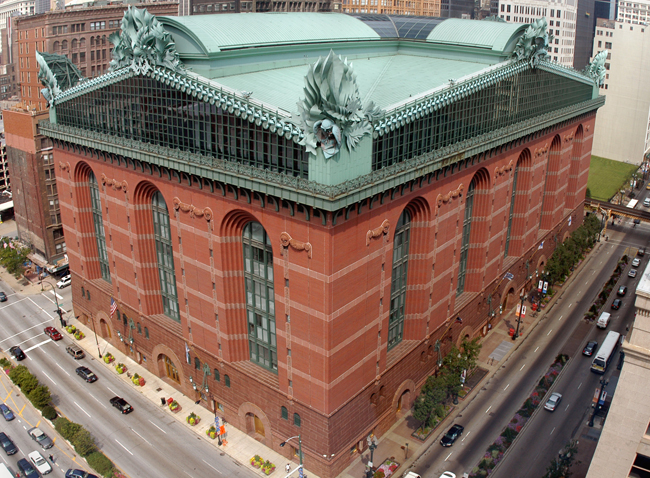
The move into the new central library began July 5 and was completed August 24. Mayor Richard M. Daley, CPL's Board of Directors and Commissioner John Duff dedicated the building October 4. After an open house October 6, Harold Washington Library Center opened October 7.
1994
Mayor Richard M. Daley appointed Mary A. Dempsey as commissioner of Chicago Public Library.
1995
Under the guidance of Commissioner Dempsey, the Library’s staff wrote a new mission statement and developed a five-year strategic plan to rebuild the Library system by improving its infrastructure in five critical areas: staff development and training, technology, funding, capital planning and materials acquisition. The mission statement is central to all Library operations and is its guiding principle:
“We welcome and support all people in their enjoyment of reading and pursuit of lifelong learning. Working together, we strive to provide equal access to information, ideas and knowledge through books, programs and other resources. We believe in the freedom to read, to learn, to discover.”
Chicago Public Library established its website, offering patrons access to a wide range of information and bibliographies, and serving as a gateway to the Internet.
1996
Bill Gates, chairman and CEO of the Microsoft Corporation, announced a $1 million gift of software and training to the Library. This donation enabled the Library to connect all 81 locations to the Internet.b
On November 13, in a show of support unmatched by any other major U.S. city, the Chicago City Council overwhelmingly approved the request of Mayor Richard M. Daley and the Chicago Public Library Board of Directors for a three-year, $65 million capital improvement plan. Under this plan, the Library and City built or renovated 52 neighborhood libraries.
1997
Library Journal honored Mayor Richard M. Daley for his support and advocacy for libraries by selecting him as its first “politician of the year.”
2000
Beginning in 2000, the City invested an additional $44 million in neighborhood library construction. These capital improvement plans ensured that all areas of Chicago would be served by modern, fully equipped and inviting neighborhood and regional libraries. This improvement in infrastructure represented 65 percent of the city’s neighborhood libraries.
2001
Chicago Public Library launched One Book, One Chicago to foster a sense of community through reading. The Library’s free programs for adults and children include author readings, story hours, exhibits, dance and musical performances, the Chicago Book Festival, Money Smart and Law at the Library lectures.
2003
The City of Chicago received an outstanding achievement award for the One Book, One Chicago program in the 2003 City Livability Awards Program sponsored by the U.S. Conference of Mayors. The awards recognize and honor mayors for exemplary leadership in developing and implementing programs that improve the quality of life in America's cities. One Book, One Chicago, sponsored by the City of Chicago and the Chicago Public Library, encourages residents to read and discuss the same book at the same time. Launched in fall 2001, the goal of One Book, One Chicago is to cultivate a culture of reading and discussion in Chicago by bringing the city’s diverse population together around a great piece of literature. The program has received international media attention, and more than 100 cities worldwide have modeled their citywide reading clubs after One Book, One Chicago.
2009
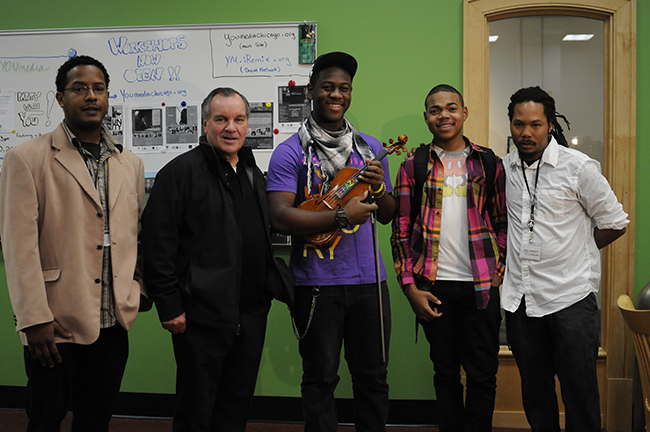
Chicago Public Library opened YOUmedia, an innovative, youth-centered learning space in partnership with the Digital Youth Network. The 5,500-square-foot space in the Harold Washington Library Center and virtual ym.iremix.org social learning network was inspired and funded by the John D. and Catherine T. MacArthur Foundation through the Chicago Public Library Foundation, along with additional funding and support from the Pearson Foundation and the City of Chicago. Based on research funded by MacArthur, YOUmedia addresses youth interaction and learning with digital media by becoming a model “out-of-school” environment created by and for teens. At YOUmedia, young adults engage in projects that promote critical thinking, creativity, skill-building and, ultimately, civic engagement with the help of adult mentors, digital resources, books, programming and workshops. The space was hailed by the White House as a model for other libraries and museums and has been replicated across the country.
2012
Mayor Rahm Emanuel appointed Brian Bannon as commissioner of Chicago Public Library.
2013
In June, Chicago Public Library launched a redesigned Summer Learning Challenge focused on science, technology, engineering, art and math (STEAM) skills to encourage more participation and provide additional opportunities for kids to grow and learn. The updated program gives children of all ages recognition for engaging in reading and hands-on creating and discovery activities aimed at encouraging 21st century skills.
The Bill & Melinda Gates Foundation awarded a $1 million grant in June for Chicago Public Library and the Aarhus Public Libraries in Denmark to work together, with the assistance of leading design firm IDEO, on creating innovative library services and programs. The Gates Foundation Global Libraries initiative believes that innovative leaders and well-trained staff are vital to creating high-impact libraries that meet the changing needs of their communities. The grant was made to the Chicago Public Library Foundation and will fund the work with IDEO as well as the projects tackled by both Chicago Public Library and Aarhus Public Libraries. The goal of the partnership between Chicago Public Library and Aarhus Public Libraries is to create a new model for innovation, experimentation and decision-making within libraries.
Chicago Public Library’s brand-new Maker Lab in July became the first free public maker space in Chicago. As the first large urban library to experiment with a maker space, CPL joins the growing movement of hands-on, collaborative learning environments in which people come together to share knowledge and resources to design, create and build items. The Maker Lab at Harold Washington Library Center was initially made possible with a grant from the Institute of Museum and Library Services to the Chicago Public Library Foundation. In October, CPL received the Social Innovator Award from Chicago Innovation Awards, which recognizes the most innovative new products or services brought to market or to public service each year, for the Maker Lab’s accomplishments in enabling new forms of personal manufacturing and business opportunities.
In September, Chicago Public Library dedicated its new Back of the Yards Branch, a neighborhood library co-located on the campus of the new Back of the Yards High School to serve as a community campus, extending learning and discovery to all residents. This full-service CPL branch includes enhanced teen-focused collections and digital learning amenities to support the work of the high school.
Throughout 2013, Chicago Public Library expanded its Teacher in the Library program, and by October offered free homework help at all 80 locations. The Library also added online tutoring help through Brainfuse. This growth makes CPL’s homework assistance program the largest and most comprehensive in the nation.
2014
In January, Chicago Public Library was ranked No. 1 in the United States and No. 3 in the world in a new international study from the Information Science Department of Heinrich Heine University Dusseldorf in Germany. The empirical study ranked the core services of public libraries across the globe, examining the 31 major urban libraries taking a leadership role in supporting “smart cities” in the “knowledge economy.”
Chicago Public Library launched a new online experience, including a redesigned website and an improved library catalog, in April. Funded by a $1 million investment from the Chicago Public Library Foundation, the new website, created in partnership with software company BiblioCommons, serves as a model public library website.
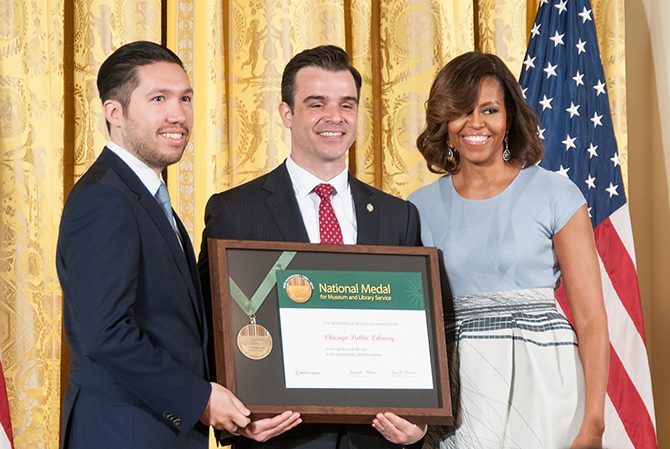
Chicago Public Library received the National Medal for Museum and Library Service on May 8. The National Medal for Museum and Library Service is the nation’s highest honor for museums and libraries, recognizing service to the community. It is presented each year by the Institute of Museum and Library Services, the primary source of federal support for the nation’s 123,000 libraries and 17,500 museums.
Chicago Public Library unveiled its new strategic vision, 2015-2017 Strategy: Building the Library of the Future, outlining the strategic priorities and goals of CPL service to Chicagoans. The strategy serves as the foundation for the Library’s work plan as CPL continues to enhance its programs, services and collection. CPL’s timeless mission remains unchanged: welcoming and supporting all people in their enjoyment of reading and pursuit of lifelong learning, and striving to serve them well and effectively by providing equal access to information, ideas and knowledge through books, programs and other resources. But CPL will also respond to the current and evolving needs of patrons by focusing on three key initiatives: nurturing learning, supporting economic advancement and strengthening communities.
2015
Seeking to bridge the digital divide, Chicago Public Library in January launched Internet to Go, take-home Internet access and digital training for people in digitally underserved areas of the city. Patrons can check out WiFi hotspots to connect a mobile-enabled device to the Internet wherever they are—at home, on the bus, in the park. CPL received $400,000 in funding from the John S. and James L. Knight Foundation as one of 19 winners out of 700 cities that applied to the Knight News Challenge. The challenge sought breakthrough ideas that strengthen the Internet for freedom of expression and innovation. Google also contributed $175,000 to support the initiative. CPL is already the city's largest provider of free Internet access through its 80 locations in Chicago communities.
The National Summer Learning Association named Chicago Public Library its first-ever winner of NSLA’s Founder’s Award in recognition of its Summer Learning Challenge aimed at eliminating the summer slide. In addition to being the inaugural winner of the Founder’s Award, Chicago Public Library is the only public library ever to win an award from the National Summer Learning Association. The National Summer Learning Association's annual awards recognize outstanding summer programs or models that demonstrate excellence in accelerating academic achievement and promoting healthy development for young people between pre-kindergarten and 12th grade.
2016
Chicago Public Library Commissioner Brian Bannon in May was ranked among the 100 Most Creative People in Business for 2016 by Fast Company. This annual list honors an influential and diverse group of leading thinkers around the globe. Bannon was recognized for his leadership in democratizing access to learning and technology across Chicago’s 80 library locations and building an entrepreneurial culture that supports innovation at all levels of the organization.
2017
Chicago Public Library opened the redesigned Thomas Hughes Children’s Library, an innovative learning center that will serve as a model for branches across the city. Located in Harold Washington Library Center, the newly remodeled 24,000-square-foot facility provides a 21st century learning experience for children and caregivers by combining traditional library service with early literacy, maker lab activities and STEAM (science, technology, engineering, art and math) learning. The space serves early learners, elementary learners and tweens with computers as well as books and play collections. The early learner area promotes play-based learning through play and includes an interactive puppet stage, a baby garden and a story nook. The elementary learner area provides STEAM-based activities and materials for school-aged children to promote inquiry-based learning. The tween area includes a digital media space where children are encouraged to explore STEAM projects that incorporate laptops, digital cameras, and blue screen and virtual reality tools. The space was funded by a $2.5 million grant from Exelon Corporation to the Chicago Public Library Foundation, the largest single gift ever made to the early learning initiatives at Chicago Public Library.
Comcast in October announced a $250,000 investment with the Chicago Public Library Foundation to support “Experience Labs” powered by Internet Essentials at three CPL locations: Woodson Regional Library, Whitney M. Young Branch and the new Altgeld Branch. This investment brings together three CPL programs—YOUmedia for teens, digital skills tutoring for adults and the Maker Lab—into a designated space at each of the three locations, creating a unique Experience Lab for Chicagoans of all ages.
2018
Chicago Park District transferred more than 161,000 photographs and drawings of public parks to Chicago Public Library’s Special Collections. This historical archival material enriches the telling of Chicago’s story, particularly with regard to how the demographics and populations served by the city’s parks have changed over time. The collection boasts more than 61,000 photographic prints processed and digitized to archival standards, covering the over 500 parks in the Chicago Park District system. These photographs are high resolution and fully searchable in the Special Collections Reading Room. The physical prints are also available upon request. 10,000 images representing 91 parks are available online via CPL's Digital Collections. Funding for this project was provided by the Gaylord and Dorothy Donnelley Foundation and the Chicago Public Library Foundation.
2019
Chicago Public Library opened its 81st location, West Loop Branch, on January 17, 2019.
Chicago Public Library opened three libraries co-located with Chicago Housing Authority mixed-income housing developments in winter 2019. These developments—featuring the Independence, Little Italy and Northtown branch libraries—strengthen communities with affordable housing and community anchors that support lifelong learning.
Mayor Lori Lightfoot appointed Andrea Telli as commissioner of Chicago Public Library effective June 15, 2019.
Chicago Public Library reopened its Legler Branch as the Legler Regional Library in June, creating a library hub on Chicago’s West Side. The location has expanded hours and will undergo renovations later in 2019.
Chicago Public Library in October eliminated overdue fines on all CPL-owned items, removing unfair barriers to basic library access and becoming the largest public library system in the United States to join the growing movement of eliminating overdue fines. Such fines have increasingly been found to be an ineffective tool in encouraging the return of library materials. This policy is the latest in a series of efforts by Mayor Lori Lightfoot to eliminate regressive fines and fees policies that have historically prevented too many Chicagoans from contributing to the local economy, and replace them with new policies to promote economic inclusion for all of Chicago’s communities.
2020
As the COVID-19 pandemic swept around the world, Chicago Public Library closed March 21 and didn't reopen until June 8, the first systemwide, health-related closure in CPL's history. During the closure, CPL continued to serve patrons and the community, including by making face shields and masks, and by expanding existing online offerings, such as eBooks and online homework help. Upon reopening, library staff offered online events to connect with patrons staying safer at home. CPL's 2020 Summer Learning Challenge, Teen Summer Challenge and One Book, One Chicago programs were fully remote.
During this unique and humbling time, Chicago Public Library introduced its new strategic plan, Chicago Public Library 2020-2024 Strategy. The strategy lays out a vision for the future that's more important now than ever, reflecting the library's critical role and commitment to provide relevant, non-biased information to help foster equity, inclusion and healing in our city.
Chicago Public Library opened a new Altgeld Branch on November 9, 2020, in collaboration with the Chicago Housing Authority. The new building, co-located with a CHA mixed-income housing development, replaced a branch library in the Altgeld Gardens Housing complex.
2021
Mayor Lori Lightfoot appointed Chris Brown as commissioner of Chicago Public Library effective February 1, 2021.

